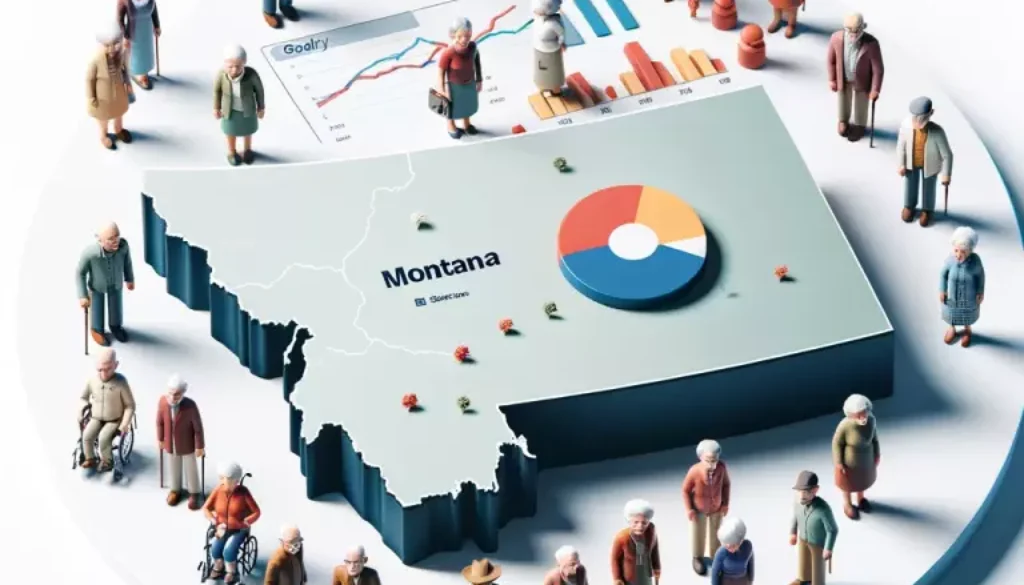Exploring Senior Demographics of Montana
Table of Contents
ToggleLast Updated on April 25, 2024 by Rachel
Introduction
Nestled within Montana’s vast landscapes, the state’s senior population, aged 65 and over, embodies resilience and diversity. With a population of 226,136 seniors, comprising 20.14% of Montana’s 1,122,867 residents, this demographic weaves an integral thread into the fabric of the state. This comprehensive analysis, drawn from the American Community Survey 2022 Census data, unveils a detailed portrayal of Montana’s senior community, spanning demographics, relationships, education, employment, income, poverty, and housing.
Demographics
Montana’s senior demographic is evenly distributed, with 47.8% males and 52.2% females, boasting a median age of 72.8 years. The racial composition is predominantly White (92.5%), with other races contributing 3.7%. A significant 92.1% identify as White alone, not Hispanic or Latino.
Relationships and Households
Within Montana’s senior community, 93.0% are part of households, showcasing strong family ties. Family households represent 52.9%, with married-couple families comprising 45.6%. Nonfamily households, including those living alone, make up 47.1%.
Marital Status
Montana’s seniors exhibit diverse marital statuses, with 59.2% currently married, 19.3% widowed, 16.8% divorced, and 4.4% never married, reflecting a rich tapestry of life experiences.
Education Status
The educational landscape among seniors is varied, with 6.4% having less than a high school education, 28.1% high school graduates, 33.5% with some college or associate’s degrees, and 32.0% holding bachelor’s degrees or higher.
Responsibility for Grandchildren
Approximately 3.3% of seniors in Montana live with their grandchildren, and 1.3% actively shoulder the responsibility for their well-being, emphasizing the multi-generational dynamics within families.
Veteran Status
A proud tradition of military service is evident, with 18.1% of Montana’s seniors being civilian veterans, highlighting the state’s commitment to the armed forces.
Disability Status
In the civilian noninstitutionalized population of seniors, 31.6% report having some form of disability, emphasizing the importance of accessibility and support services.
Residence Status
The majority of seniors (93.1%) have maintained their residence over the past year, showcasing stability. A small percentage (6.7%) has moved within the United States and abroad, reflecting a degree of mobility.
Place of Birth, Nativity, and Citizenship Status
The vast majority of seniors (98.9%) in Montana are native-born, while 1.1% are foreign-born. Among the foreign-born, 79.6% entered the United States before 2000, with 62.1% being naturalized U.S. citizens.
Language Status
English remains the primary language, spoken by 96.8% of seniors, while 3.2% speak a language other than English, emphasizing linguistic diversity within the senior community.
Employment Status
Approximately 19.2% of seniors in Montana are in the labor force, contributing to the state’s workforce resilience. Of these, 18.8% are employed, demonstrating ongoing economic engagement.
Income Status
Household Earnings
For 36.9% of senior households, earnings play a pivotal role, with a mean income of $55,817, showcasing financial stability and continued economic contributions.
Social Security Income
A substantial 90.8% of senior households receive Social Security income, with a mean of $22,469, highlighting its critical role in supporting retirees and ensuring financial well-being.
Supplemental Security Income
Supplemental Security Income (SSI) reaches 4.0% of senior households, providing additional financial support with a mean income of $11,769.
Cash Public Assistance Income
Cash public assistance income supports 2.0% of senior households, with a mean income of $3,534, acting as a supplementary financial safety net.
Retirement Income
Retirement income is a significant source for 53.5% of senior households, with a mean income of $29,483, underlining the importance of prudent retirement planning.
Mortgage Status
When considering housing costs, 74.6% of seniors in owner-occupied units have monthly expenses less than 30% of their income, promoting financial stability. The median value of owner-occupied housing is $353,000.
Food Stamp/SNAP Benefits
The safety net provided by Food Stamp/SNAP benefits is evident as 7.2% of senior households receive this support, contributing to essential nutrition and overall well-being.
Poverty Status
Among seniors, 12.5% live below 100% of the poverty level, 9.0% fall within 100 to 149 percent, while 78.5% have an income at or above 150% of the poverty level.
Housing Status
Occupied Housing Units
Montana’s seniors reside in 140,480 occupied housing units, with a strong preference for homeownership, as 79.2% are owner-occupied.
Owner-Occupied Housing Units
Within the owner-occupied segment, 74.6% have monthly costs less than 30% of their income, promoting financial stability. The median value of owner-occupied housing is $353,000.
Renter-Occupied Housing Units
For those who choose to rent, 47.3% have gross rent as a percentage of household income less than 30%, while the median gross rent is $777.
Conclusion
Montana’s senior population stands as a testament to the state’s rich heritage and resilient spirit. This detailed analysis of demographics, relationships, education, employment, income, poverty, and housing unveils the multifaceted nature of Montana’s senior community. It provides a roadmap for policymakers, community leaders, and stakeholders to develop targeted initiatives that cater to the unique needs of this cherished demographic. By fostering inclusivity, accessibility, and comprehensive support systems, Montana can continue to be a welcoming home for its seniors, ensuring their well-being and active participation in the vibrant tapestry of the state’s life.

